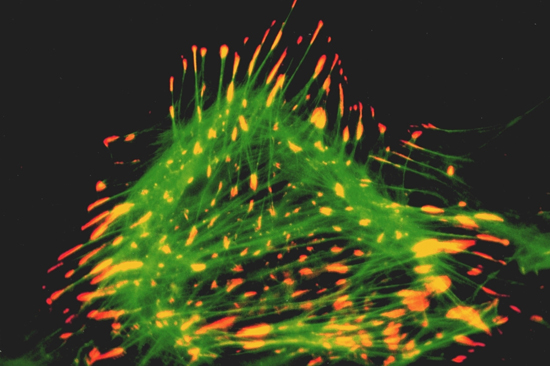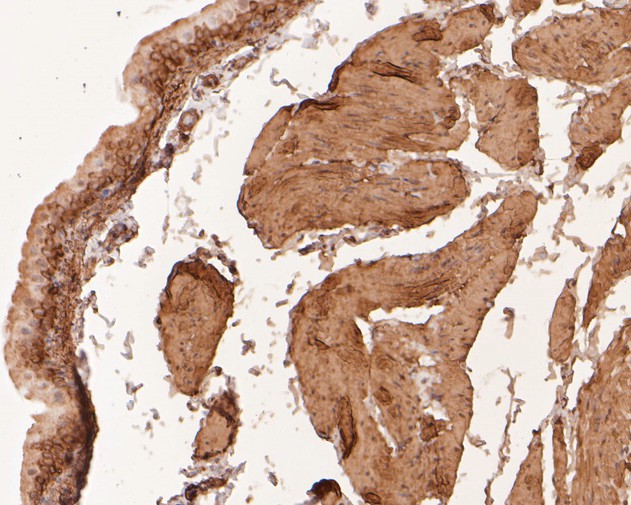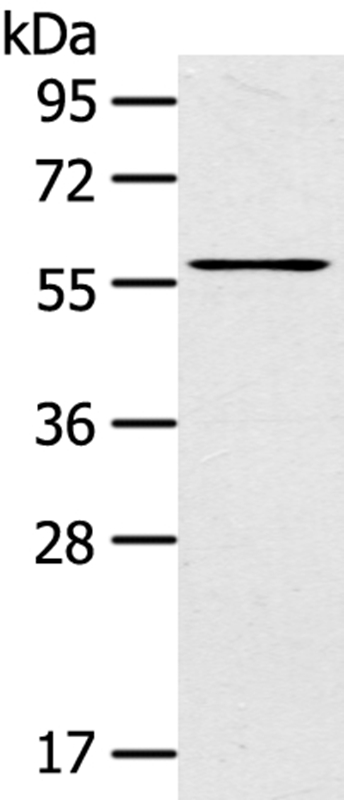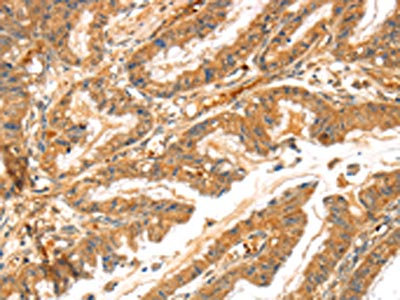
Immunocytochemical staining of a rat cardiac fibroblast using anti-Lipoma Preferred Partner, pAb (IG-817) (Prod. No. AG-25T-0106) (LPP; red fluorescence) and a green-fluorescent phalloidin derivative staining filamentous actin. LPP is a protein related to
anti-Lipoma Preferred Partner, pAb (IG-817)
AG-25T-0106
ApplicationsImmunoPrecipitation, Western Blot, ImmunoCytoChemistry
Product group Antibodies
ReactivityHuman, Porcine, Rat
TargetLPP
Overview
- SupplierAdipoGen Life Sciences
- Product Nameanti-Lipoma Preferred Partner, pAb (IG-817)
- Delivery Days Customer10
- ApplicationsImmunoPrecipitation, Western Blot, ImmunoCytoChemistry
- CertificationResearch Use Only
- ClonalityPolyclonal
- Concentration500 ug/ml
- Gene ID4026
- Target nameLPP
- Target descriptionLIM domain containing preferred translocation partner in lipoma
- Target synonymslipoma-preferred partner, LIM protein, lipoma preferred partner
- HostRabbit
- Protein IDQ93052
- Protein NameLipoma-preferred partner
- Scientific DescriptionLipoma preferred partner (LPP) is encoded by the preferred fusion partner gene of the high mobility group protein HMGI-C. LPP is frequently affected by chromosomal translocations in a major group of soft tissue lipomas, as well as in a parosteal lipoma and in pulmonary chondroid hamartomas. The resulting fusion proteins comprise three DNA binding domains of HMGI-C fused to two or three C-terminal LIM domains of LPP and a reciprocal product, respectively. Expression of a HMGI-C/LPP fusion protein causes malignant transformation of fibroblasts. Similar to its relatives zyxin and TRIP (thyroid receptor interacting protein 6) / ZRP-1 (zyxin-related protein 1), LPP consists of a N-terminal proline-rich domain followed by three C-terminal LIM domains (double zinc finger structures that are involved in protein-protein interactions). Like the cytoskeletal protein zyxin, LPP localizes to focal adhesions and cell-cell adherens junctions. LPP harbors a nuclear export signal and displays transcriptional activation capacity. - Polyclonal Antibody. Recognizes human, rat and pig LPP. Source: Rabbit. Applications: ICC, IP, WB. Liquid. In PBS containing 0.01% sodium azide. Lipoma preferred partner (LPP) is encoded by the preferred fusion partner gene of the high mobility group protein HMGI-C. LPP is frequently affected by chromosomal translocations in a major group of soft tissue lipomas, as well as in a parosteal lipoma and in pulmonary chondroid hamartomas. The resulting fusion proteins comprise three DNA binding domains of HMGI-C fused to two or three C-terminal LIM domains of LPP and a reciprocal product, respectively. Expression of a HMGI-C/LPP fusion protein causes malignant transformation of fibroblasts. Similar to its relatives zyxin and TRIP (thyroid receptor interacting protein 6) / ZRP-1 (zyxin-related protein 1), LPP consists of a N-terminal proline-rich domain followed by three C-terminal LIM domains (double zinc finger structures that are involved in protein-protein interactions). Like the cytoskeletal protein zyxin, LPP localizes to focal adhesions and cell-cell adherens junctions. LPP harbors a nuclear export signal and displays transcriptional activation capacity.
- ReactivityHuman, Porcine, Rat
- Storage Instruction-20°C,2°C to 8°C
- UNSPSC12352203





![ICC/IF analysis of HeLa cells using GTX83092 LPP antibody [8B3A11]. Green : LPP Blue: DRAQ5 fluorescent DNA dye Red: Actin filaments](https://www.genetex.com/upload/website/prouct_img/normal/GTX83092/GTX83092_20170912_ICCIF_1_w_23061322_936.webp)



